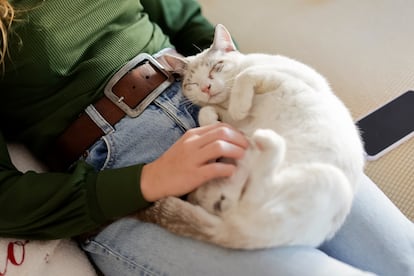What does cat purring mean?
Domestic cats are the only felines that purr when interacting with humans, a form of communication that can express happiness, pain or hunger

Purring is unique to certain feline species, including pumas, ocelots and common cats. Purring often sounds relaxing, but cats also do it in stressful or painful situations. Regardless, purring is a form of communication that remains shrouded in mystery. “Much is still unknown about why and how cats make these sounds. However, we know that cats can emit low-frequency sounds due to fatty tissue pads in their larynx,” said Stefania Pineda, a Spanish veterinarian specializing in animal behavioral and welfare medicine at the Complutense University of Madrid. Cat purring is much more than a simple, guttural reflex. “To purr, the feline’s brain needs to control the laryngeal muscles that contract to regulate the flow of air,” said Pineda.
The sound frequency of cat purring is low, between 25 and 30 Hz. It usually happens in positive and calm situations, such as when a cat is sitting on its owner’s lap. While purring, cats may also display certain body-language cues, like relaxing facial muscles and squinting. Cats will sometimes knead while purring, which is a rhythmic pushing of their paws in and out. “By purring, cats demonstrates trust in the person they’re with, but it can also happen when they’re stressed, in pain or hungry,” said Pineda.
Do felines only purr around people? “Cats sometimes purr around each other,” said Pineda, “but when they live with people, their vocalizations are primarily aimed at communicating with humans. This includes meowing. Some cats purr louder than others, possibly due to larger larynx pads. However, a cat’s comfort level with a person is not determined by their purring volume.” Pineda says kittens begin to purr when they are two or three months old, “as a social function that strengthens the bond within their litter.”
Cat-to-cat purring
Cats that still live with their siblings may purr to get their mother’s attention. “It will awaken positive emotions in the mother so she will give food and care to her kitten. It also lets the mother know where the kitten is so she can protect it from predators,” said João Pedro Monteiro, an expert in animal behavioral medicine at the Complutense University of Madrid. The common cat is the only feline that purrs when interacting with humans. “It is a form of communication that emerged with domestication. It has the power to evoke positive emotions in people, which is why some say it helps alleviate sadness,” said Monteiro. There is speculation that purring may have healing benefits for cats as well. “No conclusive studies exist, but it’s proven that cats purr when in pain, possibly to find relief.” said Monteiro.

When a cat purrs at a person, it may be conveying various messages. “If the cat knows the human, purring may indicate happiness and an invitation to interact. If there’s a stranger around, purring may be an attempt to calm the encounter and communicate that it feels no threat,” said Monteiro.
Cat kneading
Another common feline behavior is kneading, which often looks like it’s trying to fluff up a blanket or push at a person with its paws. “It’s a genetically inherited behavior. Kittens learn it from their mothers and do it to get its milk. It’s a survival behavior for newborns,” said Pineda. But the animal behavior expert notes that adult cats also demonstrate this behavior when they are relaxed, which is linked to the social relationship between the mother and her kittens.
A cat that paws at a person or another animal is trying to improve a relationship. “The cat leaves the scent of its paw pads as a sign of affection and trust towards those it has a strong bond with,” said Moreira. He believes that when a cat kneads an object, it aims to create and mark a cozy spot to rest.
Sign up for our weekly newsletter to get more English-language news coverage from EL PAÍS USA Edition
Tu suscripción se está usando en otro dispositivo
¿Quieres añadir otro usuario a tu suscripción?
Si continúas leyendo en este dispositivo, no se podrá leer en el otro.
FlechaTu suscripción se está usando en otro dispositivo y solo puedes acceder a EL PAÍS desde un dispositivo a la vez.
Si quieres compartir tu cuenta, cambia tu suscripción a la modalidad Premium, así podrás añadir otro usuario. Cada uno accederá con su propia cuenta de email, lo que os permitirá personalizar vuestra experiencia en EL PAÍS.
¿Tienes una suscripción de empresa? Accede aquí para contratar más cuentas.
En el caso de no saber quién está usando tu cuenta, te recomendamos cambiar tu contraseña aquí.
Si decides continuar compartiendo tu cuenta, este mensaje se mostrará en tu dispositivo y en el de la otra persona que está usando tu cuenta de forma indefinida, afectando a tu experiencia de lectura. Puedes consultar aquí los términos y condiciones de la suscripción digital.
More information
Últimas noticias
Most viewed
- Sinaloa Cartel war is taking its toll on Los Chapitos
- Oona Chaplin: ‘I told James Cameron that I was living in a treehouse and starting a permaculture project with a friend’
- Reinhard Genzel, Nobel laureate in physics: ‘One-minute videos will never give you the truth’
- Why the price of coffee has skyrocketed: from Brazilian plantations to specialty coffee houses
- Silver prices are going crazy: This is what’s fueling the rally











































